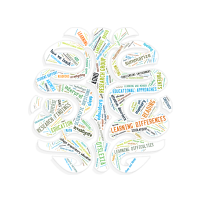

Lab Faculty and Staff
10/2/2017
ADHD and Motivation
Motivation plays an important role in goal-directed behavior, yet it can seem elusive, especially for those with Attention Deficit Hyperactivity Disorder, or ADHD...
Rewarding tasks motivate us; however, in school students are faced everyday with tasks that are not intrinsically rewarding but still need to be done. This requires effort -- and effort requires motivation. Research studies have shown us that effortful behavior requires the activation of specific brain functions, also known as executive functions, such as attention, cognitive control, emotional control, and motor control. ADHD is associated with dysfunction and underconnectivity of multiple networks in the brain, including those that control executive functions. Therefore, having ADHD adds complexity, and therefore greater challenge, to one’s ability to access motivation and reach goals.
BRAIN CHEMISTRY AND CIRCUITRY IN ADHD
Neuroimaging studies conducted in the last decade have broadened our understanding of the underlying neurobiology of ADHD. It has been theorized that one of the most common differences in children with ADHD is cognitive dysfunction due to structural differences in the frontal lobe; however, a recent meta-analysis of brain scan studies showed that abnormalities in the circuitry between multiple brain regions, not just the frontal lobe, lead to disruptions in the ability to control behavior (Rubia, et al, 2014). These networks in the brain interact with each other and include those for executive functions, reward processing, and temporal processing (i.e., timing). These same studies revealed that structural abnormalities in those with ADHD are most consistently in the basal ganglia, not in the frontal lobe as commonly believed. The basal ganglia is believed to play a key role in regulating motor responses, and the extensive connections between the basal ganglia and the frontal regions implies circuit abnormalities between these regions. Furthermore, the neurotransmitter, dopamine, plays an important role in basal ganglia function. Dopamine is a chemical in the brain that helps control how our brains recognize and process rewards and how we regulate movement and control emotions. It also helps us take action to move toward a desired goal. In other words, dopamine is essential to motivation. In those with ADHD, dopamine has been found to function differently, leading to dysregulated motivation (Rubia, et al, 2014).
NEURODEVELOPMENT IN ADHD
Motivation that leads to adaptive action is dependent on how sensitive our brain is to rewards and how well we regulate our responses (Telzer, 2016). The human brain matures significantly during adolescence in specific networks, including the reward system and the regulatory system. Brain maturation during adolescence is known as “developmental plasticity,” because the brain at this stage is significantly malleable. Brain plasticity allows us to learn and adapt as a result of our experiences, and during adolescence the systems involved are extremely responsive to stimulation and vulnerable to harm. Developmental plasticity actually involves changes in the fundamental neural structure of the brain as a result of experience. In comparison, after our mid-twenties, “adult plasticity” only involves subtle changes to already existing circuits in the brain. During the period of enhanced neural plasticity in adolescence, entirely new pathways of learning are formed and existing pathways are made more efficient through a “pruning” process of axonal branching and myelination (Steinberg, 2014). Just like a tree needs to be pruned to allow other branches to grow stronger, our brain pathways need to be pruned to allow for more efficient functioning. In the adolescent brain, the reward systems are already well developed and the regulatory systems are still immature in development. When these two systems interact together, the inverse relationship creates a ‘perfect storm’ that helps explain many adolescent behaviors.
For those with ADHD, the developmental divide between the systems for reward processing and executive functioning is even wider. The differences found in children and adolescents with ADHD seem to be associated with several aspects of maturational delay in brain development (Rubia, et al, 2014). The ventral striatum (VS), a key component of the basal ganglia involved in reward processing, integrates information regarding cognition, motor control, and motivation. A 2015 study by Fosco, et al, found that for adolescents with ADHD-Combined Type, the response between the ventral striatum and motor regions is exaggerated when processing rewards; however, their exaggerated response to rewards does not necessarily improve their performance on a task, suggesting that this connectivity is inefficient. In addition, brain scans have shown deficits in the white matter between multiple brain regions in ADHD patients suggesting reduced “pruning” (Ma, et al, 2016). This means less efficiency when signals travel between regions. It’s like having to travel from point A to point B by taking meandering country roads where others can take a direct interstate highway.
Other aspects of neurodevelopment in the ADHD brain suggest a maturational delay as well. Longitudinal imaging studies have shown that the structural brain development (peak of cortical thickness and surface area) of children with ADHD is delayed by 2 to 5 years compared to non-ADHD peers (Rubia, et al, 2014). Lastly, their meta-analysis of timing functions in the brain showed patients with ADHD had consistently reduced activation in the left hemisphere during tasks involving time estimation, time discrimination, motor timing, and temporal foresight. Fortunately, these brain regions have been shown to increase in activation progressively between childhood and adulthood during motor inhibition, attention, and timing tasks. Thus, many of us, including those with ADHD, outgrow these symptoms in adulthood.
References
Berry, Katherine A., and Sandra M. Loughlin. "COGNITIVE AND AFFECTIVE ENGAGEMENT, ARTS INTEGRATION, AND STUDENTS WITH DISABILITIES." Arts Integration and Special Education: An Inclusive Theory of Action for Student Engagement (2014): 46.
Fosco, Whitney D., et al. "Evaluating cognitive and motivational accounts of greater reinforcement effects among children with attention-deficit/hyperactivity disorder." Behavioral and Brain Functions 11.1 (2015): 20.
Kohn, Alfie. Punished by rewards: The trouble with gold stars, incentive plans, A's, praise, and other bribes. Houghton Mifflin Harcourt, 1999.
Ma, Ili, et al. "Ventral striatal hyperconnectivity during rewarded interference control in adolescents with ADHD." cortex 82 (2016): 225-236.
Plamondon, André, and Rhonda Martinussen. "Inattention symptoms are associated with academic achievement mostly through variance shared with intrinsic motivation and behavioral engagement." Journal of attention disorders(2015): 1087054715587098.
Rubia, Katya, Analucia Alegria, and Helen Brinson. "Imaging the ADHD brain: disorder-specificity, medication effects and clinical translation." Expert review of neurotherapeutics 14.5 (2014): 519-538.
Steinberg, Laurence. Age of opportunity: Lessons from the new science of adolescence. Houghton Mifflin Harcourt, 2014.
Telzer, Eva H. "Dopaminergic reward sensitivity can promote adolescent health: A new perspective on the mechanism of ventral striatum activation." Developmental cognitive neuroscience 17 (2016): 57-67.
Westbrook, Andrew, and Todd S. Braver. "Dopamine does double duty in motivating cognitive effort." Neuron 89.4 (2016): 695-710.
Yarmolovsky, Jessica, et al. "Hot executive control and response to a stimulant in a double-blind randomized trial in children with ADHD." European archives of psychiatry and clinical neuroscience (2016): 1-10.




